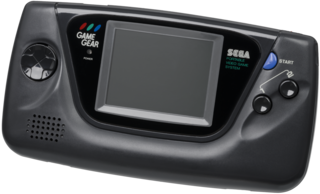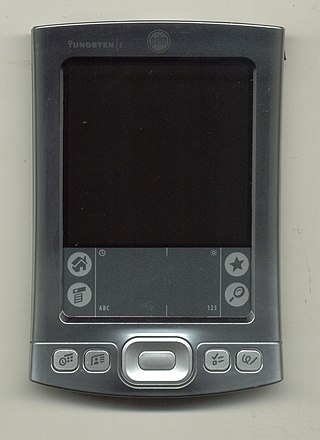
A handheld game console, or simply handheld console, is a small, portable self-contained video game console with a built-in screen, game controls and speakers. Handheld game consoles are smaller than home video game consoles and contain the console, screen, speakers, and controls in one unit, allowing players to carry them and play them at any time or place.

The Game Gear is an 8-bit fourth generation handheld game console released by Sega on October 6, 1990, in Japan, in April 1991 throughout North America and Europe, and during 1992 in Australia. The Game Gear primarily competed with Nintendo's Game Boy, the Atari Lynx, and NEC's TurboExpress. It shares much of its hardware with the Master System, and can play Master System games through the use of an adapter. Sega positioned the Game Gear, which had a full-color backlit screen with a landscape format, as a technologically superior handheld to the Game Boy.

Amstrad was a British consumer electronics company, founded in 1968 by Alan Sugar. During the 1980s, the company was known for its home computers beginning with the Amstrad CPC and later also the ZX Spectrum range after the Sinclair deal, which led it to have a substantial share of the PC market in Britain. In the following decade it shifted focus towards communication technologies, and its main business during the 2000s was the manufacture of satellite television set-top boxes for Sky, which Amstrad had started in 1989 as the then sole supplier of the emerging Sky TV service.

Sky Network Television Limited, more commonly known as Sky, is a New Zealand broadcasting company that provides pay television services via satellite, media streaming services, and broadband internet services. As of 31 December 2022, Sky had 1,023,378 residential television subscribers consisting of 517,003 satellite subscribers and 506,375 streaming subscribers. Additionally, Sky had 23,156 broadband customers. Despite the similarity of name, branding and services, such as Sky Go and MySky shared with its European equivalent, Sky Group, there is no connection between the companies.

Sinclair, Inc., doing business as Sinclair Broadcast Group, is a publicly traded American telecommunications conglomerate that is controlled by the descendants of company founder Julian Sinclair Smith. Headquartered in the Baltimore suburb of Cockeysville, Maryland, the company is the second-largest television station operator in the United States by number of stations, owning or operating a total of 193 stations across the country in over 100 markets, and is the largest owner of stations affiliated with Fox, NBC, CBS, ABC, MyNetworkTV, and The CW. Sinclair also owns four digital multicast networks, and sports-oriented cable networks. On June 2, 2021, it was announced that Sinclair had become a Fortune 500 company, having reached 2020 annual revenues of US$5.9 billion.

Kojak is an American action crime drama television series starring Telly Savalas as the title character, New York City Police Department Detective Lieutenant Theophilus "Theo" Kojak. Taking the time slot of the popular Cannon series, it aired on CBS from 1973 to 1978.

The Tungsten series was Palm, Inc.'s line of business-class Palm OS-based PDAs.
Sinclair Radionics Ltd was a company founded by Sir Clive Sinclair in Cambridge, England which developed hi-fi products, radios, calculators and scientific instruments.
The history of video game consoles, both home and handheld, began in the 1970s. The first console that played games on a television set was the 1972 Magnavox Odyssey, first conceived by Ralph H. Baer in 1966. Handheld consoles originated from electro-mechanical games that used mechanical controls and light-emitting diodes (LED) as visual indicators. Handheld electronic games had replaced the mechanical controls with electronic and digital components, and with the introduction of Liquid-crystal display (LCD) to create video-like screens with programmable pixels, systems like the Microvision and the Game & Watch became the first handheld video game consoles.

WPGH-TV is a television station in Pittsburgh, Pennsylvania, United States, affiliated with the Fox network. It is owned by Sinclair Broadcast Group alongside dual CW and MyNetworkTV affiliate WPNT. The two stations share studios on Ivory Avenue in the city's Summer Hill neighborhood, where WPGH-TV's transmitter is also located.

MediaFLO was a technology developed by Qualcomm for transmitting audio, video and data to portable devices such as mobile phones and personal televisions, used for mobile television. In the United States, the service powered by this technology was branded as FLO TV.
WPMT is a television station licensed to York, Pennsylvania, United States, serving as the Fox affiliate for the Susquehanna Valley region. Owned by Tegna Inc., the station maintains studios on South Queen Street in Spring Garden Township. Through a channel sharing agreement with Harrisburg–licensed PBS member WITF-TV, the two stations transmit using WITF-TV's spectrum from an antenna in Susquehanna Township.

WHNT-TV is a television station in Huntsville, Alabama, United States, affiliated with CBS. It is owned by Nexstar Media Group alongside Florence-licensed CW owned-and-operated station WHDF. The two stations share studios on Holmes Avenue Northwest in downtown Huntsville; WHNT-TV's transmitter is located on Monte Sano Mountain. The station also operates three news bureaus: Decatur, Sand Mountain (Albertville), and Shoals (Florence).

An ultra-mobile PC, or ultra-mobile personal computer (UMPC), is a miniature version of a pen computer, a class of laptop whose specifications were launched by Microsoft and Intel in Spring 2006. Sony had already made a first attempt in this direction in 2004 with its Vaio U series, which was only sold in Asia. UMPCs are generally smaller than subnotebooks, have a TFT display measuring (diagonally) about 12.7 to 17.8 centimetres, are operated like tablet PCs using a touchscreen or a stylus, and can also have a physical keyboard. There is no clear boundary between subnotebooks and ultra-mobile PCs, but UMPCs commonly have major features not found in the common clamshell laptop design, such as small keys on either side of the screen, or a slide-out keyboard.
A handheld television is a portable device for watching television that usually uses a TFT LCD or OLED and CRT color display. Many of these devices resemble handheld transistor radios.

The Japanese multinational consumer electronics company Nintendo has developed seven home video game consoles and multiple portable consoles for use with external media, as well as dedicated consoles and other hardware for their consoles. As of September 30, 2021, in addition to Nintendo Switch, Nintendo has sold over 863.07 million hardware units.

The Nintendo DSi is a dual-screen handheld game console released by Nintendo. The console launched in Japan on November 1, 2008, and worldwide beginning in April 2009. It is the third iteration of the Nintendo DS, and its primary market rival was Sony's PlayStation Portable (PSP). The fourth iteration, entitled Nintendo DSi XL, is a larger model that launched in Japan on November 21, 2009, and worldwide beginning in March 2010. Development of the DSi began in late 2006, and the handheld was unveiled during an October 2008 Nintendo conference in Tokyo. Consumer demand convinced Nintendo to produce a slimmer handheld with larger screens than the DS Lite. Consequently, Nintendo removed the Game Boy Advance (GBA) cartridge slot to improve portability without sacrificing durability.

The PlayStation Vita is a handheld game console developed and marketed by Sony Computer Entertainment. It was first released in Japan on December 17, 2011, and in North America, Europe, and other international territories beginning on February 22, 2012. The console is the successor to the PlayStation Portable, and a part of the PlayStation brand of gaming devices; as part of the eighth generation of video game consoles, it primarily competed with the Nintendo 3DS.
The Yaesu VX series is a line of two sequences of compact amateur radio handheld transceivers produced by Yaesu. There is a line of ultra-compact lower-power dual-band transceivers that started with the VX-1R and was later updated with the VX-2R and VX-3R. There is also a line of 5W tri-band transceivers that started with the VX-5R and was later updated with the VX-6R, VX-7R and VX-8R.

The attempted acquisition of Tribune Media by Sinclair Broadcast Group was a proposed broadcast media transaction between Sinclair Broadcast Group and Tribune Media. Formally announced on May 8, 2017, the $3.9 billion deal would have resulted in Sinclair owning—or having operational control over—stations available in 72% of all households with a television set in the United States.
















